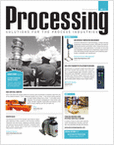Tuesday, July 15, 2008
Display problem ? Click HERE
Recommended :
Subscribe FREE - Processing Magazine

There was an incident happened recently near a factory involved 3 cars on the roads. A small truck carried 2 Acetylene gas cylinders and 2 Oxygen gas cylinder at the back caught fire in the middle of road. The cylinder on fire flew like a bullet, hit at first car, penetrated the car roof and final stopped after hit at second car front bumper. No details revealed...
Subscribe FREE - Processing Magazine

There was an incident happened recently near a factory involved 3 cars on the roads. A small truck carried 2 Acetylene gas cylinders and 2 Oxygen gas cylinder at the back caught fire in the middle of road. The cylinder on fire flew like a bullet, hit at first car, penetrated the car roof and final stopped after hit at second car front bumper. No details revealed...
Following are some photos captured for view :
Acetylene (IUPAC name: ethyne) , C2H2, is a unstable and unsaturated triple bonded hydrocarbon in gas form. It common store as compressed gas in cylinder. Similarly an Oxygen cylinder is compressed oxygen store in cylinder. Acetylene and Oxygen are commonly used for welding (known as Oxy-acetylene welding), cutting, heat treatment and coating. As the car carried Acetylene & Oxygen gas cylinder, it is obvious that the owner use them for welding and cutting purpose.
Recommended :
Subscribe FREE - Chemical Processing
 A simple Material Safety Datasheet (MSDS) for Acetylene is located here (click here). From the MSDS, acetylene is extremely flammable (low flash point) and explosive. IT MAY DECOMPOSE VIOLENTLY IN ITS FREE STATE UNDER PRESSURE IN EXCESS OF 15 PSIG.
A simple Material Safety Datasheet (MSDS) for Acetylene is located here (click here). From the MSDS, acetylene is extremely flammable (low flash point) and explosive. IT MAY DECOMPOSE VIOLENTLY IN ITS FREE STATE UNDER PRESSURE IN EXCESS OF 15 PSIG.
Following is a video clip shows you how "explosive" is if Acetylene mix with Oxygen.
(If you can not view the video clip, click here to view via browser)
How "explosive" is if Acetylene mix with Oxygen
If you or your operators are handling compressed gas i.e. Acetylene, Oxygen, Nitrogen, etc, be sure you and your operators are well aware of the properties of the gases, the way to handle, transport and operate them in the safe manner. Following are collection of article that helps you to educate yourself or your operators :
Gas Cylinder Awareness Outline
The purpose of this awareness training is to help staff and students understand how compressed gas cylinders (CGC) work and how to handle them safely. The training should address the following objectives:
This program contains requirements for practices designed and implemented to protect University employees from the hazards of compressed gases as identified by the University and as defined by OSHA in 29 CFR 1910, the National Fire Protection Association (NFPA) and the Compressed Gas Association (CGA).
Gas Cylinder Safety
A brief discussion on grades of gases, normal storage pressure, type of fitting and regulators used, transportation, storage, how to keep safe of compressed gases, problems related to regulators, information on fire and other aspect.
Gas Cylinder Handling & Storage
Gas cylinders are constructed and maintained in accordance with regulations of the Department of Transportation (DOT). The purchaser should make sure all cylinders bear DOT specification markings, and the contents should be legibly marked on each cylinder in large letters....
Compressed Gas Cylinder Storage and Handling
Compressed gas cylinders are used in many workplaces to store gases that vary from extremely flammable (acetylene) to extremely inert (helium). Many compressed gas cylinders are stored at extremely high pressures (up to 2,500 pounds per square inch gauge or PSIG). A sudden release of these gases can cause a cylinder to become a missile-like projectile. Cylinders have been known to penetrate concrete-block walls. If handled properly compressed gas cylinders are safe. If handled improperly, the same cylinders can present a severe hazard to you and the surrounding area.
Guidelines for Gas Cylinders
This document is an advisory text which sets out general guidelines for the safe storage and handling of gas cylinders. Further information may be obtained from the documented references and the Heath, Safety & Environment Unit. Gas cylinders are used in many University work areas. Approved methods of handling, storage and transport will ensure safe use by the University staff and contractors.
Acetylene, the Principles of Its Generation and Use
A practical handbook on the production, purification and subsequent treatment of Acetylene for the development of light, heat and power.
Take care with acetylene
This leaflet is for people who use acetylene for welding, cutting and similar processes. It provides information on the fire and explosion hazards of acetylene.
Acetylene Safety Alert
The following safety alert was provided to Dynamic Industries, Inc. by one of our clients and did not occur on any of our projects or work sites. However, we should be aware of the hazards associated with the use of acetylene due to the work processes in which peform do on a daily basis.
Compressed Gas Leak Procedure
Use the following recommended procedures if leaks are detected on compressed gas cylinders or in gas supply systems.
The Beginners Guide to Oxy-Acetylene Welding Equipment
The purpose of this page is to introduce the beginning welder to the equipment used in the Oxy-Acetylene welding process. This will be done starting with the cylinders and ending with the torch tip.
Related Post
Recommended :
Subscribe FREE - Chemical Processing
 A simple Material Safety Datasheet (MSDS) for Acetylene is located here (click here). From the MSDS, acetylene is extremely flammable (low flash point) and explosive. IT MAY DECOMPOSE VIOLENTLY IN ITS FREE STATE UNDER PRESSURE IN EXCESS OF 15 PSIG.
A simple Material Safety Datasheet (MSDS) for Acetylene is located here (click here). From the MSDS, acetylene is extremely flammable (low flash point) and explosive. IT MAY DECOMPOSE VIOLENTLY IN ITS FREE STATE UNDER PRESSURE IN EXCESS OF 15 PSIG.Following is a video clip shows you how "explosive" is if Acetylene mix with Oxygen.
(If you can not view the video clip, click here to view via browser)
How "explosive" is if Acetylene mix with Oxygen
If you or your operators are handling compressed gas i.e. Acetylene, Oxygen, Nitrogen, etc, be sure you and your operators are well aware of the properties of the gases, the way to handle, transport and operate them in the safe manner. Following are collection of article that helps you to educate yourself or your operators :
Gas Cylinder Awareness Outline
The purpose of this awareness training is to help staff and students understand how compressed gas cylinders (CGC) work and how to handle them safely. The training should address the following objectives:
- Understand the inherent dangers of compressed gas cylinders
- Look to hazard labels, warning signs and MSDS for important information
- Selection of appropriate PPE when working with gas cylinders
- Know how to properly move, handle and store cylinders
- Know what to do in case the cylinder or delivery system develops a leak (e.g., trouble-shooting and emergency procedures)
- Know what problems can occur when installing a cylinder in a gas delivery system (e.g., installing a regulator on a cylinder)
- Know how to check cylinders for potential problems
This program contains requirements for practices designed and implemented to protect University employees from the hazards of compressed gases as identified by the University and as defined by OSHA in 29 CFR 1910, the National Fire Protection Association (NFPA) and the Compressed Gas Association (CGA).
Gas Cylinder Safety
A brief discussion on grades of gases, normal storage pressure, type of fitting and regulators used, transportation, storage, how to keep safe of compressed gases, problems related to regulators, information on fire and other aspect.
Gas Cylinder Handling & Storage
Gas cylinders are constructed and maintained in accordance with regulations of the Department of Transportation (DOT). The purchaser should make sure all cylinders bear DOT specification markings, and the contents should be legibly marked on each cylinder in large letters....
Compressed Gas Cylinder Storage and Handling
Compressed gas cylinders are used in many workplaces to store gases that vary from extremely flammable (acetylene) to extremely inert (helium). Many compressed gas cylinders are stored at extremely high pressures (up to 2,500 pounds per square inch gauge or PSIG). A sudden release of these gases can cause a cylinder to become a missile-like projectile. Cylinders have been known to penetrate concrete-block walls. If handled properly compressed gas cylinders are safe. If handled improperly, the same cylinders can present a severe hazard to you and the surrounding area.
Guidelines for Gas Cylinders
This document is an advisory text which sets out general guidelines for the safe storage and handling of gas cylinders. Further information may be obtained from the documented references and the Heath, Safety & Environment Unit. Gas cylinders are used in many University work areas. Approved methods of handling, storage and transport will ensure safe use by the University staff and contractors.
Acetylene, the Principles of Its Generation and Use
A practical handbook on the production, purification and subsequent treatment of Acetylene for the development of light, heat and power.
Take care with acetylene
This leaflet is for people who use acetylene for welding, cutting and similar processes. It provides information on the fire and explosion hazards of acetylene.
Acetylene Safety Alert
The following safety alert was provided to Dynamic Industries, Inc. by one of our clients and did not occur on any of our projects or work sites. However, we should be aware of the hazards associated with the use of acetylene due to the work processes in which peform do on a daily basis.
Compressed Gas Leak Procedure
Use the following recommended procedures if leaks are detected on compressed gas cylinders or in gas supply systems.
The Beginners Guide to Oxy-Acetylene Welding Equipment
The purpose of this page is to introduce the beginning welder to the equipment used in the Oxy-Acetylene welding process. This will be done starting with the cylinders and ending with the torch tip.
Related Post
Labels: Accident, Ebook, Safety
0 Comments:
Post a Comment
Let us know your opinion !!! You can use some HTML tags, such as <b>, <i>, <a>
Subscribe to Post Comments [Atom]
Home:
<< Home